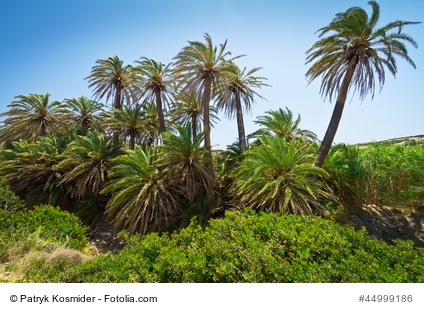Crete, the largest of the Greek islands, is a botanical paradise boasting a rich and diverse flora that reflects its unique geographical and climatic conditions. Positioned at the crossroads of three continents—Europe, Asia, and Africa—Crete’s landscapes offer a tapestry of plant life that is unparalleled in the Mediterranean. This text explores the biodiversity of Cretan flora, its significance, and the conservation efforts needed to protect this natural heritage.
The Diversity of Cretan Flora
Crete’s varied topography, from high mountains and deep gorges to coastal plains and lush valleys, creates a multitude of habitats supporting an extraordinary range of plant species. The island is home to approximately 2,000 species of plants, of which around 10% are endemic, meaning they are found nowhere else in the world.
1. Endemic Species: Crete’s endemic flora includes some of the most unique and rare plant species. The Cretan dittany (Origanum dictamnus), known locally as “diktamo,” is perhaps the most famous. This aromatic herb, found on steep mountain slopes, has been prized since ancient times for its medicinal properties. Another notable endemic plant is the Cretan maple (Acer sempervirens), a small tree that grows in the island’s rocky habitats.
2. Mediterranean Shrublands: The Mediterranean shrublands, or “maquis,” are a dominant feature of Crete’s landscapes. These areas are characterized by dense, evergreen shrubs such as juniper (Juniperus phoenicea), mastic tree (Pistacia lentiscus), and various species of sage (Salvia). These hardy plants are well-adapted to the island’s dry, hot summers and mild, wet winters.
3. Mountain Flora: Crete’s mountainous regions, particularly the White Mountains (Lefka Ori), the Dikti Mountains, and the Ida Range (Psiloritis), host a diverse array of alpine plants. These include the Cretan rockrose (Cistus creticus), various species of thyme (Thymus spp.), and the rare Cretan tulip (Tulipa cretica). The high-altitude zones provide a refuge for many endemic species that have adapted to the harsh, rocky environment.
4. Coastal and Wetland Vegetation: The coastal areas and wetlands of Crete are equally diverse. Coastal dunes are home to sand-loving plants such as sea daffodils (Pancratium maritimum) and marram grass (Ammophila arenaria). Wetlands, including lakes and river estuaries, support aquatic plants and serve as crucial habitats for migratory birds.
The Ecological and Cultural Significance
The biodiversity of Cretan flora is not only an ecological treasure but also an integral part of the island’s cultural heritage and traditional practices.
1. Medicinal and Culinary Uses: Many of Crete’s native plants have been used for centuries in traditional medicine and cuisine. Herbs such as thyme, oregano, and rosemary are staples in Cretan cooking, adding flavor and health benefits to local dishes. The therapeutic uses of plants like dittany and sage are well-documented, with these herbs traditionally employed to treat a variety of ailments.
2. Pollination and Ecosystem Services: Cretan flora plays a vital role in supporting pollinators, including bees, butterflies, and other insects. These pollinators are essential for the reproduction of many plants and the production of crops such as olives and grapes, which are crucial to the island’s economy. Additionally, the diverse plant life helps to maintain soil health, prevent erosion, and regulate the local climate.
3. Cultural Practices and Traditions: The rich flora of Crete has deeply influenced the island’s cultural practices and traditions. Plant motifs are common in Minoan art and architecture, reflecting the significance of nature in ancient Cretan society. Many local festivals and customs are tied to the seasonal cycles of plants, celebrating the harvests and the blooming of specific flowers.
Conservation Challenges and Efforts
Despite its rich biodiversity, Crete’s flora faces several threats that require concerted conservation efforts to ensure its protection.
1. Habitat Loss and Degradation: Urbanization, agricultural expansion, and infrastructure development have led to habitat loss and degradation. Coastal development, in particular, poses a significant threat to dune and wetland ecosystems. Protecting and restoring these habitats is crucial for preserving the island’s biodiversity.
2. Climate Change: Climate change presents a significant challenge to the conservation of Cretan flora. Changes in temperature and precipitation patterns can affect the distribution and health of plant species. Adaptation strategies, such as conserving genetic diversity and restoring degraded habitats, are essential for building resilience against climate change.
3. Invasive Species: Invasive plant species can outcompete native flora, leading to a decline in biodiversity. Managing invasive species through monitoring, control measures, and public awareness campaigns is necessary to protect native plant communities.
4. Overharvesting: The overharvesting of certain wild plants for medicinal, culinary, or ornamental purposes can threaten their populations. Sustainable harvesting practices and cultivation initiatives can help reduce the pressure on wild plant populations.
5. Conservation Initiatives: Several initiatives are underway to conserve Crete’s unique flora. Botanical gardens, such as the Botanical Park & Gardens of Crete, play a key role in the conservation and study of native plants. Protected areas, including national parks and Natura 2000 sites, provide safe havens for many endangered and endemic species. Local communities and NGOs are also actively involved in conservation efforts, promoting sustainable practices and raising awareness about the importance of preserving biodiversity.
Conclusion
The rich and diverse flora of Crete is a testament to the island’s unique geographical and climatic conditions. From endemic herbs and Mediterranean shrublands to alpine flowers and coastal vegetation, the plant life of Crete is a vital component of its natural heritage. This biodiversity supports ecological health, cultural practices, and economic activities, making it essential to the island’s identity. By addressing conservation challenges and promoting sustainable practices, Crete can ensure that its botanical treasures are preserved for future generations to enjoy. Through the combined efforts of local communities, conservationists, and policymakers, the vibrant tapestry of Cretan flora can continue to thrive in the Mediterranean landscape.


